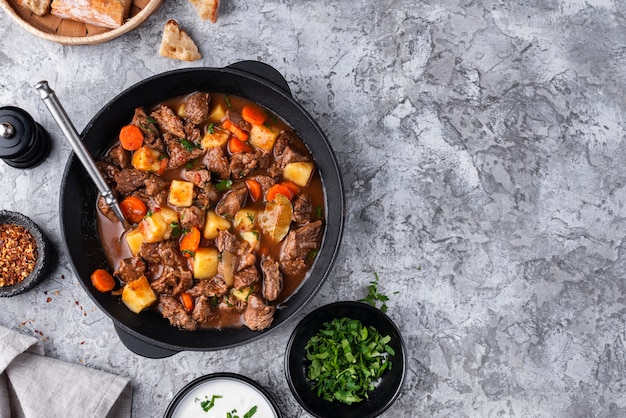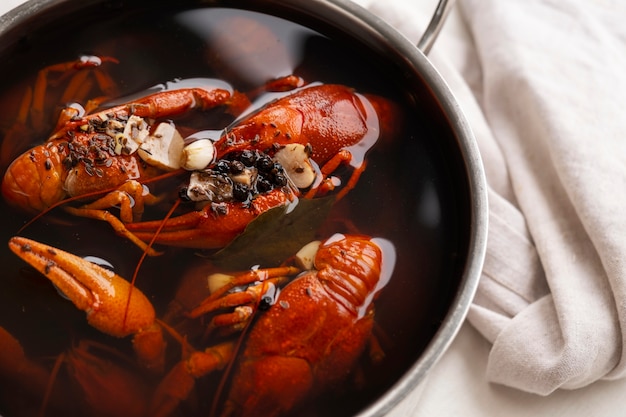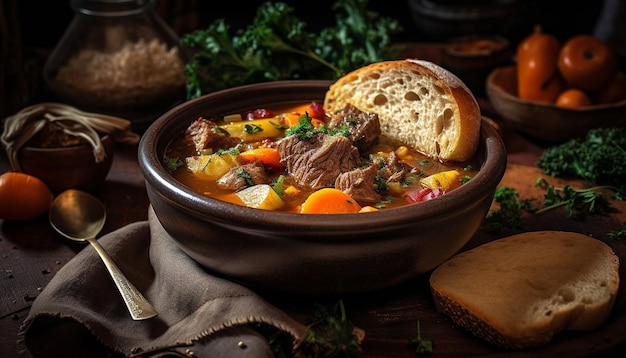There's something deeply comforting about the aroma of beef stew bubbling away in a slow cooker, filling your home with warmth and a promise of deliciousness. It’s a dish that whispers of cozy nights by the fire, hearty meals shared with loved ones, and the simple pleasure of nourishing food prepared with love. Today, I'm sharing my go-to crock pot beef stew recipe, one that I've perfected over years of experimenting and tweaking. It’s a foolproof recipe that delivers the most tender, flavorful, and soul-satisfying beef stew you've ever tasted.
So, grab a mug of hot tea, settle in, and let’s embark on a culinary journey together, exploring the magic of slow cooking, the importance of selecting the right ingredients, and the joy of creating a dish that truly embodies comfort food at its finest.
(Part 1) The Magic of Slow Cooking

Slow cooking is an art form, a gentle dance between time, heat, and ingredients. It’s about letting the flavours meld, deepen, and transform, revealing a symphony of tastes that you can’t achieve through any other cooking method.
The Alchemy of Slow Cooking: Transforming Humble Ingredients
Imagine taking a simple handful of ingredients - a piece of beef, some vegetables, herbs, and spices - and transforming them into something extraordinary, something that melts in your mouth and warms you from the inside out. That’s the magic of slow cooking. It’s a bit like alchemy, a process of patient transformation that yields results that are far greater than the sum of their parts.
The Gentle Heat: Key to Tenderness and Depth of Flavor
The secret lies in the slow, even heat. A low temperature allows the connective tissues in the meat to break down, releasing moisture and transforming tough cuts into melt-in-your-mouth tenderness. This gentle heat also gives the flavours time to mingle, creating a rich, complex broth that is a symphony of taste.
Why a Crock Pot is Your Slow Cooking Best Friend
Crock pots are the unsung heroes of slow cooking, offering a hands-off approach that’s perfect for busy lives. Imagine throwing all your ingredients into the crock pot, setting the timer, and then going about your day, free from the worries of constant stirring or monitoring. When you return, you’ll be greeted by a symphony of aromas and a perfectly cooked stew, ready to be devoured.
- Effortless Cooking: Simply toss in the ingredients, set it, and forget it.
- Hands-Free Convenience: No need for constant stirring or monitoring.
- Consistent Results: The slow, even heat ensures tender, flavorful results every time.
- Warm and Cozy Ambiance: The gentle hum of the crock pot creates a cozy atmosphere in your kitchen.
(Part 2) Choosing the Right Beef: The Star of the Show

The beef is the heart of the stew, the foundation upon which all the other flavours build. choosing the right cut is crucial, as it will determine the texture and flavour of your final masterpiece. While many cooks swear by chuck roast, others prefer brisket. Both are excellent choices for slow cooking, each offering a unique texture and flavour profile.
Chuck Roast: A Classic Choice for Tender and Flavourful Stew
Chuck roast, a cut from the shoulder of the cow, is known for its rich marbling and connective tissue. This marbling is what gives the beef its incredible flavour and tenderness when cooked slowly. The connective tissue breaks down, releasing its moisture and creating a rich, succulent stew.
Other Cuts to Consider: Exploring Alternative Options
If you can't find chuck roast, don’t despair! There are other cuts that work wonderfully in a slow-cooked beef stew. Brisket, rump roast, and even a tougher cut like round roast can all be transformed into tender, flavourful stew meat with the magic of slow cooking. Just be sure to choose a cut that’s meant for slow cooking, as these cuts are tougher and will benefit from the extended cooking time.
The Importance of Trimming: Preparing Your Beef for Success
Before you start cooking, give your beef a good trim. Remove any excess fat or gristle, as these can affect the texture and flavour of the stew. I usually trim the beef to about half an inch thickness to ensure even cooking and a more tender final product.
Browning the Beef: A Flavor Boost
Browning the beef is a crucial step in creating a truly flavourful stew. It creates a delicious crust on the outside of the beef, which adds depth and complexity to the overall flavour profile. Heat a little oil in a large skillet over medium-high heat and sear the beef on all sides until it's nicely browned. Don't worry if it's not cooked through at this point, we're just looking for that delicious crust.
(Part 3) Assembling Your Stew: Layering in Flavors

With the beef prepped and browned, we’re ready to assemble the stew, a process that’s as much about layering in flavours as it is about combining ingredients.
The Essential Trio: Building a Foundation of Flavor
There are a few essential ingredients that I always include in my beef stew. They form the foundation upon which the other flavours build, creating a harmonious blend of taste.
- Onion: The heart of any good stew, onions provide sweetness and a base for the other flavours to meld upon.
- Garlic: A touch of garlic adds depth of flavour and warmth, bringing a subtle, yet essential element to the stew.
- Carrot: Carrots add sweetness and a beautiful orange hue, creating a visually appealing and flavourful addition to the stew.
Adding Colour and Depth: Building a Symphony of Flavor
To give our stew a vibrant colour and a complex flavour profile, I like to add some other vegetables. These additions add a variety of textures and flavours, creating a well-rounded and delicious stew.
- Potatoes: Potatoes add heartiness, a creamy texture, and a satisfying element to the stew.
- Celery: Celery provides a nice crunch and herbaceous flavour, adding a refreshing contrast to the other ingredients.
- Mushrooms: A delicious addition with an earthy, umami flavour, mushrooms add depth and complexity to the stew.
The Magic of Herbs and Spices: Unleashing a World of Flavor
Herbs and spices are the secret ingredients that elevate a good stew to greatness. They add a whole new dimension of flavour, creating a symphony of aromas and tastes that tantalize the palate.
- Thyme: Thyme adds a warm, earthy note to the stew, complementing the beef and vegetables beautifully.
- Rosemary: Rosemary provides a slightly piney, herbaceous flavour that adds a unique dimension to the stew.
- Bay Leaves: Bay leaves add a subtle, earthy flavour and fragrance that enhances the overall depth of the stew.
- Paprika: A pinch of paprika adds a hint of smokiness, creating a warm and comforting element to the stew.
Finishing Touches: Adding the Final Elements of Flavor
The finishing touches are what truly elevate a stew to perfection. I always use a blend of beef broth and tomato paste, adding richness, depth, and a hint of tanginess to create a truly harmonious and satisfying flavour.
(Part 4) The Slow Cook: Patience is Key
With all the ingredients nestled in your crock pot, the waiting game begins. This is where the magic of slow cooking really shines, as time works its wonders, transforming the ingredients into a culinary masterpiece.
The Patience of a Slow Cooker: Letting Time Work Its Magic
Set your crock pot on low and let it simmer for 6-8 hours, or on high for 3-4 hours. The longer you cook it, the more tender the beef will become and the richer the flavours will be. It’s a testament to the fact that good things take time.
Checking for Tenderness: Ensuring a Perfect Outcome
After a few hours, check the beef for tenderness. It should be easily shredded with a fork, signifying that it’s reached its peak of tenderness. If it’s still a little tough, just let it cook for another hour or two, allowing the slow heat to do its magic.
The Allure of the Aroma: A Culinary Symphony
While the stew is simmering, your kitchen will be filled with the most delicious aromas, a fragrant symphony that promises pure culinary bliss. It’s like an invitation to a warm and cozy evening, a reminder that the simple pleasures in life often lead to the greatest joys.
(Part 5) Finishing Touches and Serving: Elevating the Stew to Perfection
Once the stew is cooked to perfection, it's time to give it a final touch, a final flourish that elevates the dish to new heights.
Thickening the Gravy: Achieving the Perfect Consistency
The gravy should be nice and thick, coating the beef and vegetables in a luscious sauce. If it’s a bit thin, you can thicken it with a cornstarch slurry. Just whisk together a couple of tablespoons of cornstarch and a little cold water until smooth, then stir it into the stew. Let it simmer for a few minutes, and your gravy will thicken up beautifully.
Adding a Final Burst of Flavor: Enhancing the Taste Profile
I like to add a dollop of sour cream or crème fra??che just before serving. It adds a touch of tanginess and richness that really elevates the stew, creating a beautiful balance of flavours.
Garnishing for Style: A Visual Delight
To make your stew look extra special, you can garnish it with fresh herbs, a sprinkle of chopped parsley, or a drizzle of olive oil. It’s all about presentation, isn’t it? A little bit of visual flair can elevate the dining experience, making the dish even more appealing and inviting.
(Part 6) Serving Suggestions: Exploring Culinary Creativity
This beef stew is incredibly versatile, offering a blank canvas for culinary creativity. It can be served in so many ways, allowing you to tailor it to your own preferences and dining style.
Traditional and Cozy: A Classic Comfort Food Experience
Serve your stew with a side of fluffy mashed potatoes, crusty bread, or buttery biscuits. This classic combination provides a comforting and satisfying meal, perfect for a chilly evening.
A Touch of Elegance: Elevating the Stew to a New Level
Spoon your stew over a bed of creamy polenta or rice pilaf. This pairing adds a touch of elegance and sophistication to the dish, making it perfect for a special occasion or dinner party.
A Hearty Meal: A Satisfying and Flavorful Experience
Top your stew with a dollop of sour cream or crème fra??che and a sprinkle of chopped fresh herbs. Serve with a side salad. This combination provides a hearty and flavorful meal, offering a balance of textures and flavours.
Comforting Bowl of Warmth: Pure Indulgence
Simply enjoy a bowl of hot stew on a cold winter's day. It's perfect for a cozy night in, a moment of pure indulgence and comfort.
(Part 7) Variations and Twists: Exploring Culinary Creativity
Don't be afraid to get creative with your beef stew! It's a recipe that invites experimentation, allowing you to personalize it to your own taste preferences. Here are a few variations to try, each offering a unique twist on the classic dish.
Spicy Kick: Adding a Touch of Heat
Add a pinch of cayenne pepper or a few jalape??os to your stew for a spicy kick. This variation adds a touch of heat to the stew, making it perfect for those who enjoy a bit of spice.
Rich and Creamy: A Decadent Treat
Stir in a cup of heavy cream or milk for a richer, creamier stew. This variation creates a luxurious and decadent stew, perfect for a special occasion.
Hearty and Filling: A Satisfying and Nourishing Meal
Add a handful of pearl barley or brown rice for a more hearty and filling stew. This variation adds a satisfying texture and a boost of protein, making it a perfect meal for a cold winter’s day.
A Taste of the Orient: Exploring International Flavors
Add a few tablespoons of soy sauce, ginger, and garlic for a delicious Asian-inspired twist. This variation introduces a unique flavour profile, adding a touch of the Orient to your stew.
The Power of Wine: A Rich and Complex Flavor
For a richer, more complex flavour, deglaze the pan after browning the beef with a cup of red wine. This step adds a depth of flavour and complexity to the stew, making it truly irresistible.
(Part 8) Leftovers? No Problem!
One of the best things about beef stew is that it’s even better the next day. The flavours have a chance to meld and deepen overnight, and the beef becomes even more tender.
Reheating Tips: Ensuring a Delicious Second Serving
You can reheat your stew on the stovetop, in the microwave, or even in the oven. I prefer to reheat it on the stovetop over low heat, stirring occasionally until it’s heated through. This method ensures that the stew heats evenly and doesn’t become too thick or dry.
Freezing for Later: Storing Your Stew for Future Enjoyment
You can also freeze your stew for later. Just let it cool completely, then transfer it to an airtight container and freeze for up to 3 months. To reheat frozen stew, thaw it overnight in the refrigerator and then reheat on the stovetop.
FAQs: Addressing Common Questions
What are the best vegetables for beef stew?
You can use any vegetables you like in your stew, but I always include carrots, potatoes, celery, and onions. They provide a classic flavour combination that perfectly complements the beef. Mushrooms, peas, green beans, and even parsnips are delicious additions as well, adding variety and depth to the stew.
Can I use a different cut of beef?
Yes, you can use a different cut of beef, but choose one that’s meant for slow cooking, like brisket, rump roast, or round roast. These cuts are tougher and will benefit from the extended cooking time in the slow cooker, becoming incredibly tender and flavourful.
Can I make this in a slow cooker without browning the beef first?
Yes, you can, but browning the beef first will add a ton of flavor to your stew. The browning process creates a delicious crust on the beef, which adds depth and complexity to the overall flavour profile. If you don’t have time to brown the beef, you can still make a delicious stew. Just add the beef to the slow cooker with the other ingredients and cook it for a longer period of time, allowing the slow heat to tenderize the beef and develop the flavours.
How long can I keep leftover beef stew in the refrigerator?
You can keep leftover beef stew in the refrigerator for up to 3 days. The flavours will continue to meld and deepen during this time, making the stew even more delicious.
Can I freeze leftover beef stew?
Yes, you can freeze leftover beef stew for up to 3 months. Just let it cool completely, then transfer it to an airtight container and freeze. To reheat frozen stew, thaw it overnight in the refrigerator and then reheat on the stovetop.
(Part 9) Conclusion: A Recipe for Comfort, a Legacy of Flavor
Well, there you have it, my recipe for the perfect crock pot beef stew, a recipe that embodies the essence of comfort food. It's a dish that evokes memories of cozy evenings spent with loved ones, a reminder that the simplest things in life often lead to the greatest joys. It’s a legacy of flavour, a dish that has been passed down through generations, bringing warmth and nourishment to countless families. So, gather your ingredients, set your crock pot to low, and let the magic begin, creating a culinary masterpiece that will become a cherished tradition in your own home.
Everyone is watching

Perfect Rice Every Time: The Ultimate Guide to Cooking Rice
Cooking TipsAs a self-proclaimed foodie, I've always been a bit obsessed with rice. It's the foundation of countless cuisi...

Prime Rib Roast Cooking Time Chart: Per Pound Guide
Cooking TipsPrime rib roast. Just the name conjures images of lavish dinners, crackling fires, and hearty laughter. It’s ...

The Ultimate Guide to Cooking Asparagus: Tips, Techniques, and Recipes
Cooking TipsAsparagus. The mere mention of this spring delicacy conjures up images of vibrant green spears, crisp and burs...

Ultimate Guide to Cooking the Perfect Thanksgiving Turkey
Cooking TipsThanksgiving. Just the word conjures up images of overflowing tables laden with delicious food, the scent of r...

How Long to Bake Potatoes in the Oven (Perfect Every Time)
Cooking TipsBaked potatoes are a staple in my kitchen. They're incredibly versatile, delicious, and surprisingly easy to m...
